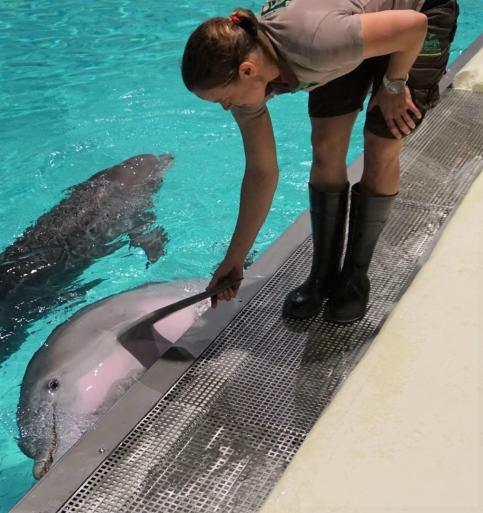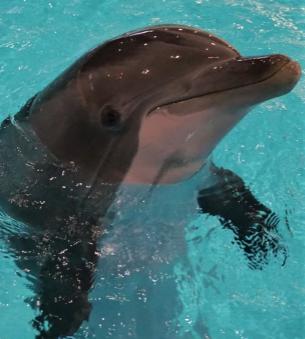Background & Aims

Background
The welfare of dolphins under human care depend largely on how well the animal caretakers manage to stimulate the animals throughout the day. Stimulation can for example come in the form of enrichment or social interactions with conspecifics and caretakers. One example of a stimulating interaction between dolphins and caretakers is training sessions.
During the dolphin training at Kolmården Zoo, each session starts with one of the trainers making a hand-slap on the water surface. This hand-slap is the current call-over signal that informs the dolphins that the session has started. Upon hearing this hand-slap, all dolphins are expected to swim towards the trainer that made the signal.
Once all dolphins are gathered, they are devided between trainers. This too is done through the use of the hand-slap as a call-over signal for each dolphin being sent away from the gathered group to a new trainer. However, this procedure is rather time consuming, and often result in miscommunication between dolphin and trainer.
What if there was a simpler way of deviding the dolphin group between trainers?
What if this way could be to use individual call-over signals?
And what if these call-over signals could be their own signature whistles?

What is a Signature whistle?
Dolphins use stereotyped, individually distinctive, frequency modulated whistles, referred to as signature whistles, in order to broadcast their identity. You may think of these whistles as the dolphins' names.
Most of the time they only whistle their own signature, as if I were to walk around saying "Tilde, Tilde, Tilde", and you would answer using your name. However, occasionally, they also copy each others' signature whistles in order to address specific individuals.
The identity information in signature whistles lie in each whistle's unique frequency modulation pattern rather than in the voice features of the whistle owner.
Now you may wonder what is meant by "The Whistle caller concept" in the title of this project.
Well, The Whistle caller concept is based on the fact that dolphins sometimes copy each others' signature whistles. This copying is, as mentioned, likely in order to contact specific individuals and convene.
By using playbacks of signature whistles as call-over signals for dolphins under human care, it should be possible to call individual dolphins over while other dolphins in the group know that they're not addressed.

Aims
The aim of this study was to prove the Whistle caller concept of using signature whistles as individual call-over signals for dolphins in human care.
Two hypotheses were tested:
1. Dolphins call-over trained with a playback of their own signature whistle will learn to come on this signal faster (i.e., in a fewer number of training sessions) than dolphins call-over trained with a playback of a biologically irrelevant "trivial" sound.
2. Upon hearing other sounds, dolphins trained with their own signature whistle will be able to discriminate between their own and other dolphins' signature whistles better than dolphins trained with a "trivial" sound will be able to discriminate between their own and other trivial sounds.
Ariel, the first dolphin in this project
to be call-over trained with a playback
of her own signature whistle.
How did you know that the dolphin was made of wood?
It wooden whistle!
Responsible for this page:
Director of undergraduate studies Biology
Last updated:
05/14/21
